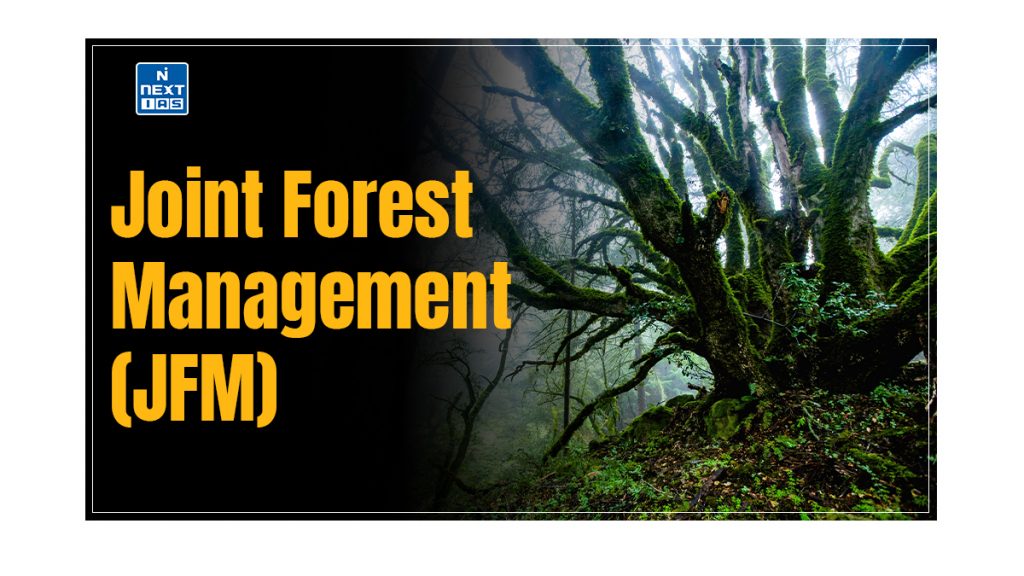
The Joint Forest Management (JFM) initiative represents a significant shift from traditional state-centric forest management to a more inclusive model. Ever since its inception, it has contributed significantly to forest management and conservation in India. This article aims to study in detail the Joint Forest Management initiative of India, its key provisions, significance and related aspects.
What is Joint Forest Management (JFM)?
- Joint Forest Management is a community-based approach to forest conservation and management in India that emerged as a response to the challenges of forest degradation and the need for sustainable forest management.
- In a shift from traditional state-centric forest management in the country, this initiative envisages active participation of the local communities in the protection and sustainable use of forest resources.
- It was initiated in the context of the National Forest Policy of 1988 wherein state forest departments support local forest dwelling and forest fringe communities to protect and manage forests and share the costs and benefits from the forests with them.
- It gives a definite share with respect to final and intermittent products from the regenerated forest areas.
- These shares are much more than what was available to these members under their traditional entitlement under the original forests on revenue settlement.
- Village-level Joint Forest Management Committees (JFMCs) lie at the core of the implementation of this initiative.
Joint Forest Management Committee (JFMC)
- The JFMC represents a democratic institution at the village level.
- The Forest Departments and the Village Communities are partners in the village-level Committees.
- The General Body of the Committee consists of all willing adult members of villages and is chaired by the President who is elected by consensus on majority vote.
- For day-to-day functioning of the Committee, the members elect an Executive Body. The President of the General Body is also the President of EB.
- To ensure effective and meaningful participation of women and other section of society, there are ample provisions in the policy guidelines.
- The JFMC is also known by different names in different States, such as Forest Protection Community (FPC), Village Forest Committee (VFC), Van Sanrakshan Samiti (VSS) etc.
- A Micro Plan is prepared by the Committee, which represents the document and includes the basic data about the village and the various proposed activities in the next five to ten years.
- This document is prepared in accordance with the activities identified by the local communities.
- The Committee takes up various activities related to conservation protection, afforestation of different models, nursery raising, soil and moisture conservation work, awareness generation, management entry point activities, forest protection, livelihood improvement and development of forests.
Benefits of JFM Initiative
- Economic benefits, such as the use of fuelwood and timber and non-timber produce, help the marginalised. It has been a substitute income for farmers in times of distress.
- Employment is achieved through wage work, the creation of assets, poverty reduction, and livelihood options.
- Ecological restoration through Increased forest cover, improvement of soil moisture regime and crop protection in farms of adjoining forest areas and reduces soil erosion.
- Ensures livelihood security through Self Help Groups (SHGs) to realise the full potential of their skills and resources. In many villages, leaf plate making, silk warm rearing, bamboo basket making and other accessories, honey collection and processing, vermin-composting and eco-tourism are being taken.
- It involves greater participation from women in the workforce which could result in equitable growth.
- It has huge ecological benefits because the trade-off between the development and conservation of forests can be minimised with the effective participation of people.
Challenges of Joint Forest Management
- Weak Gram Panchayats: In many cases, Gram Panchayats lack the capacity to effectively manage their activities.
- Benefit Sharing Issues: Equitable distribution of benefits among community members remains contentious and challenging.
- Lack of Technical Expertise: Communities often lack the technical knowledge required for sustainable forest management.
- External Pressures: Illegal activities such as encroachment and deforestation can undermine the efforts.
Conclusion
The Joint Forest Management has emerged as a successful model for forest conservation and management in India. By empowering local communities and promoting collaborative partnerships, it has contributed to improved forest health, livelihood enhancement, and conflict reduction. Addressing the challenges and building upon its strengths will be crucial for its continued success.
Frequently Asked Questions (FAQs)
What is the full form of JFM?
It stands for Joint Forest Management.
Who started JFM in India?
It was started by the Ministry of Environment & Forest, Government of India.






